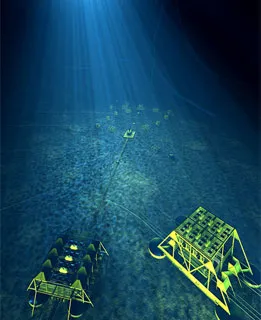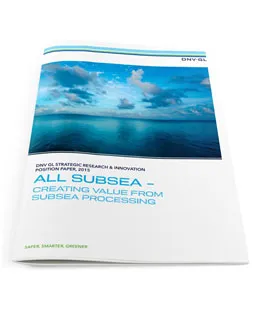DNV GL today launched a research paper exploring the viability of moving offshore oil and gas processing subsea, including the techno-economics of an ‘all subsea’ solution. The report addresses current limitations, but also highlights opportunities for subsea technology.
To lend clarity to the topic, the paper compares a benchmark FPSO set-up with a hypothetical all-subsea field development solution. However, instead of making a direct comparison between the two alternatives, the paper adopts a stepwise approach, moving the various main parts of the processing from the topside to the seabed in nine steps until nothing remains on the surface.
Cutting through complexity
Principal researcher and lead author of the paper, Tore Kuhnle, said: “Debates about the viability of ‘all subsea’ solutions can quickly become overwhelmed with complexity due to the interrelations and dependencies between the processing, power, control and safety subsystems, as well as the effects on the reservoir performance and commercial aspects. With our stepwise approach, one can evaluate the business case of subsea solutions progressively and with clarity.”
For each step, the report includes a business case assessment of whether:
- The step is enabling (i.e. opens up new opportunities for the industry that other technological solutions cannot achieve); and/or is enhancing ( i.e. that that aspect of subsea processing offers superior efficiency relative to any other technical solution)
- A bright future for subsea, also in the current market.
“The industry has moved from ‘breaking boundaries’ to ‘cost cutting’ in recent years. In that respect, it is reassuring to see that subsea processing is both enabling and enhancing technology for brownfield applications,” added Kuhnle. “Even though brownfields will continue to drive subsea processing development, we have also identified possibilities for greenfield applications. We see that the technology has matured considerably for limited-depth and limited-range applications. With our short-term focus, we see the completely submerged alternative more as a mature-area, midsize oilfield solution, rather than an extreme deepwater, long-range problem-solver. I’d say these are good findings for the industry to consider as we need efficient production replacement projects in the current market, and both these alternatives fit very nicely.”
Elisabeth Tørstad, CEO, DNV GL - Oil & Gas, says,"For DNV GL, it is important to provide foresight and seek alternative solutions which lie far in the future while looking for short-term improvements. This specific research shows that subsea processing is essential to enable prolonged production from mature fields. There are also indications that complete subsea solutions may be a new option for medium sized fields in mature areas."


